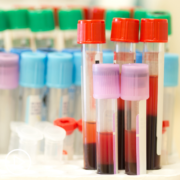Is Monosomy 13 a High-Risk Marker for Myeloma?
Is Monosomy 13 a High-Risk Marker for Myeloma? from Patient Empowerment Network on Vimeo.
High-risk multiple myeloma has some markers, but is monosomy 13 one of these markers? Dr. Sikander Ailawadhi from the Mayo Clinic explains the monosomy 13 marker, chromosome mutations, and how specialists locate high-risk markers.
See More from START HERE Myeloma
Related Programs:

|

|

|
Transcript:
Lisa Hatfield:
All right, what are we learning about monosomy 13 in myeloma, is it a high-risk marker for myeloma?
Dr. Sikander Ailawadhi:
So, Lisa, I think that’s an extremely important question because there has been historically a lot of discussion about a deletion 13, monosomy 13 deletion 13, meaning a portion of the 13th chromosome missing. Monosomy 13 meaning one…so half of the chromosome missing, because everybody has two of each chromosome, one set from the father, one from the mother, so one set is missing, that is monosomy, or one arm is missing its monosomy if a portion of the chromosome is missing deletion.
Historically, quite some years ago, deletion 13 or monosomy 13 was in itself a high-risk marker, then the drugs or called the pareso inhibitor family, in which one of them is bortezomib (Velcade) came about, and it showed that whether the patient had deletion 13 or no outcomes were similar when they got bortezomib, so it was no longer a high-risk marker. In current day and age, there are certain mutations that are considered high risk, monosomy 13 or deletion 13 by itself is not considered a high-risk marker, but the co-presence of deletion 13 or monosomy 13 with some other mutations is considered higher risk just because it is telling us about more widespread genetic damage in the myeloma genetic material.
So, for example, if somebody has a mutation called 1Q gain or 1Q+, as some patients may read in their FISH report, if that one to gain co-exists with deletion 13 or month, the risk of that one can is even higher. So by itself modulators, but it’s coexistence, but some other mutations bring up the risk category higher.
Lisa Hatfield:
Okay, thank you. And just to clarify for maybe somebody who’s just learning about their myeloma diagnosis and the cytogenetics of that, when you’re talking about these mutations, are you specifically talking about these mutations are only in the myeloma cells, they aren’t all in their body, and they’re overall in any other cells, just the myeloma cell.
Dr. Sikander Ailawadhi:
Absolutely, you’re spot-on. So these mutations that are tested in the abnormal plasma cells from the bone marrow, which the term used for that is somatic mutation, disease-related mutations in the disease cells, these are not mutations that we were born with or we inherited.
So if somebody was to take a sample from a healthy blood cell or a myeloma patient’s swab from the mouth or a spit sample that is not expected to carry these mutations, it is only the cancerous abnormal plasma cells from the bone marrow or a myeloma cell that have these mutations.



